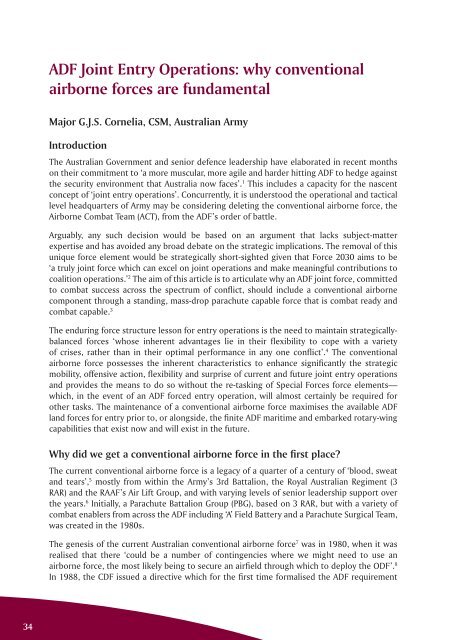ISSUE 183 : Nov/Dec - 2010 - Australian Defence Force Journal
ISSUE 183 : Nov/Dec - 2010 - Australian Defence Force Journal
ISSUE 183 : Nov/Dec - 2010 - Australian Defence Force Journal
You also want an ePaper? Increase the reach of your titles
YUMPU automatically turns print PDFs into web optimized ePapers that Google loves.
ADF Joint Entry Operations: why conventionalairborne forces are fundamentalMajor G.J.S. Cornelia, CSM, <strong>Australian</strong> ArmyIntroductionThe <strong>Australian</strong> Government and senior defence leadership have elaborated in recent monthson their commitment to ‘a more muscular, more agile and harder hitting ADF to hedge againstthe security environment that Australia now faces’. 1 This includes a capacity for the nascentconcept of ‘joint entry operations’. Concurrently, it is understood the operational and tacticallevel headquarters of Army may be considering deleting the conventional airborne force, theAirborne Combat Team (ACT), from the ADF’s order of battle.Arguably, any such decision would be based on an argument that lacks subject-matterexpertise and has avoided any broad debate on the strategic implications. The removal of thisunique force element would be strategically short-sighted given that <strong>Force</strong> 2030 aims to be‘a truly joint force which can excel on joint operations and make meaningful contributions tocoalition operations.’ 2 The aim of this article is to articulate why an ADF joint force, committedto combat success across the spectrum of conflict, should include a conventional airbornecomponent through a standing, mass-drop parachute capable force that is combat ready andcombat capable. 3The enduring force structure lesson for entry operations is the need to maintain strategicallybalancedforces ‘whose inherent advantages lie in their flexibility to cope with a varietyof crises, rather than in their optimal performance in any one conflict’. 4 The conventionalairborne force possesses the inherent characteristics to enhance significantly the strategicmobility, offensive action, flexibility and surprise of current and future joint entry operationsand provides the means to do so without the re-tasking of Special <strong>Force</strong>s force elements—which, in the event of an ADF forced entry operation, will almost certainly be required forother tasks. The maintenance of a conventional airborne force maximises the available ADFland forces for entry prior to, or alongside, the finite ADF maritime and embarked rotary-wingcapabilities that exist now and will exist in the future.Why did we get a conventional airborne force in the first place?The current conventional airborne force is a legacy of a quarter of a century of ‘blood, sweatand tears’, 5 mostly from within the Army’s 3rd Battalion, the Royal <strong>Australian</strong> Regiment (3RAR) and the RAAF’s Air Lift Group, and with varying levels of senior leadership support overthe years. 6 Initially, a Parachute Battalion Group (PBG), based on 3 RAR, but with a variety ofcombat enablers from across the ADF including ‘A’ Field Battery and a Parachute Surgical Team,was created in the 1980s.The genesis of the current <strong>Australian</strong> conventional airborne force 7 was in 1980, when it wasrealised that there ‘could be a number of contingencies where we might need to use anairborne force, the most likely being to secure an airfield through which to deploy the ODF’. 8In 1988, the CDF issued a directive which for the first time formalised the ADF requirement34
















